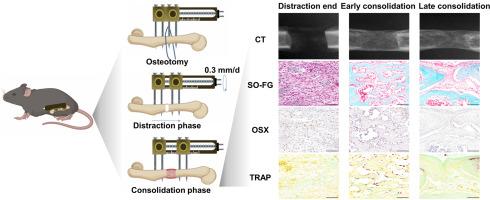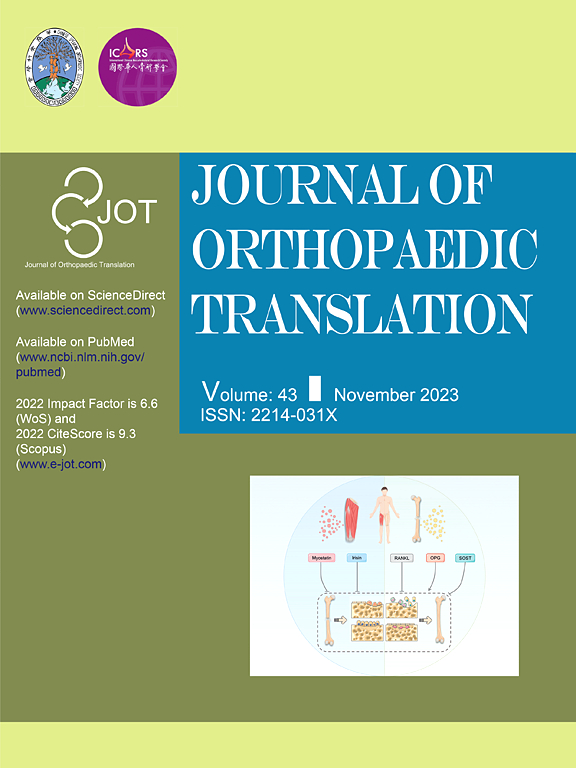Development of a standardized and reproducible murine femoral distraction osteogenesis model
IF 5.9
1区 医学
Q1 ORTHOPEDICS
引用次数: 0
Abstract
Objective
Distraction osteogenesis (DO) has been widely used to treat bone defects as its effectiveness in bone regeneration. Currently, distraction devices for establishing DO models are mainly developed for rats or large animals. However, a mouse DO model is in great need for in-depth mechanistic investigations using various transgenic mice. The current study reports the development of a reproducible murine DO model.
Methods
A mini-titanium lengthener was designed and fabricated. The mini-lengthener was applied on the murine femur with four threaded pins using a designed clamp as the drilling and insertion guide. After transverse osteotomy using a Gigli saw, and after 5 days of latency, DO procedures started at 0.3 mm/day for 10 days, and the consolidation period was left for 28 days. The bone formation was monitored by radiography and histology. Potential effects on animal locomotion during DO were also measured by behavior tests.
Results
Separated bone segments maintained good alignment during the entire DO phases. New bone formation was found as early as the end of the distraction phase. Active bone remodeling was found between the separated bone segments at late distraction and early consolidation phases. At the mature consolidation phase, bone remodeling was mainly observed in the contact cortical bone. Mice underwent DO procedure did not have significant impairment in their locomotion.
Conclusion
We have successfully developed a murine femoral DO model, which may be used to study the biological processes of DO. We also developed the mini-lengthener and the guide clamp to ensure the standardization and reproducibility of the mouse DO model.
The translational potential of this article: Current study reports the development of a murine femoral DO model. A well-established murine DO model will facilitate further investigations of the biological mechanisms of DO in various transgenic and normal mice.

开发标准化、可重复的小鼠股骨牵张成骨模型
目的牵引成骨(DO)因其在骨再生方面的有效性而被广泛用于治疗骨缺损。目前,用于建立牵引成骨模型的牵引装置主要是针对大鼠或大型动物开发的。然而,利用各种转基因小鼠进行深入的机理研究亟需一种小鼠 DO 模型。本研究报告了一种可重复的小鼠 DO 模型的开发过程。使用设计好的夹钳作为钻孔和插入导向,将微型延长器用四个螺纹销钉固定在小鼠股骨上。在使用 Gigli 锯进行横向截骨后,经过 5 天的潜伏期,开始以每天 0.3 毫米的速度进行 DO 程序,持续 10 天,巩固期为 28 天。骨形成情况通过射线照相术和组织学进行监测。在整个 DO 阶段,分离的骨段保持良好的排列。新骨形成早在牵引阶段结束时就已发现。在牵引晚期和巩固早期,分离的骨段之间出现了活跃的骨重塑。在成熟巩固阶段,主要在接触皮质骨中观察到骨重塑。结论我们成功建立了小鼠股骨DO模型,可用于研究DO的生物学过程。我们还开发了微型延长器和导钳,以确保小鼠 DO 模型的标准化和可重复性:目前的研究报告了小鼠股骨DO模型的建立。一个完善的小鼠DO模型将有助于进一步研究各种转基因小鼠和正常小鼠DO的生物学机制。
本文章由计算机程序翻译,如有差异,请以英文原文为准。
求助全文
约1分钟内获得全文
求助全文
来源期刊

Journal of Orthopaedic Translation
Medicine-Orthopedics and Sports Medicine
CiteScore
11.80
自引率
13.60%
发文量
91
审稿时长
29 days
期刊介绍:
The Journal of Orthopaedic Translation (JOT) is the official peer-reviewed, open access journal of the Chinese Speaking Orthopaedic Society (CSOS) and the International Chinese Musculoskeletal Research Society (ICMRS). It is published quarterly, in January, April, July and October, by Elsevier.
 求助内容:
求助内容: 应助结果提醒方式:
应助结果提醒方式:


